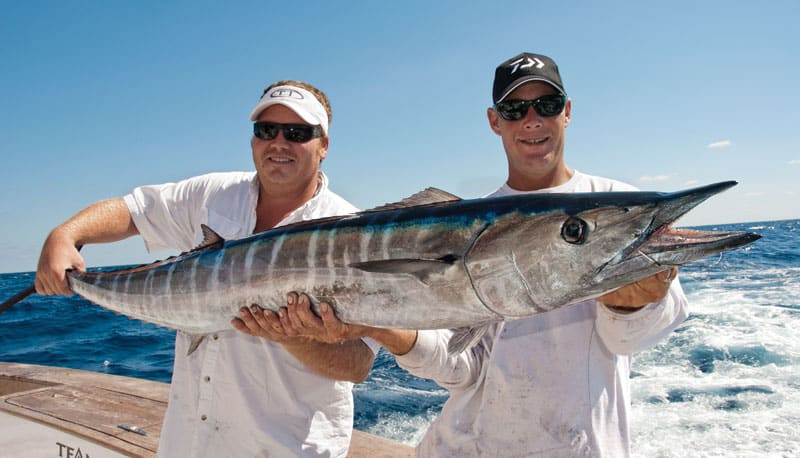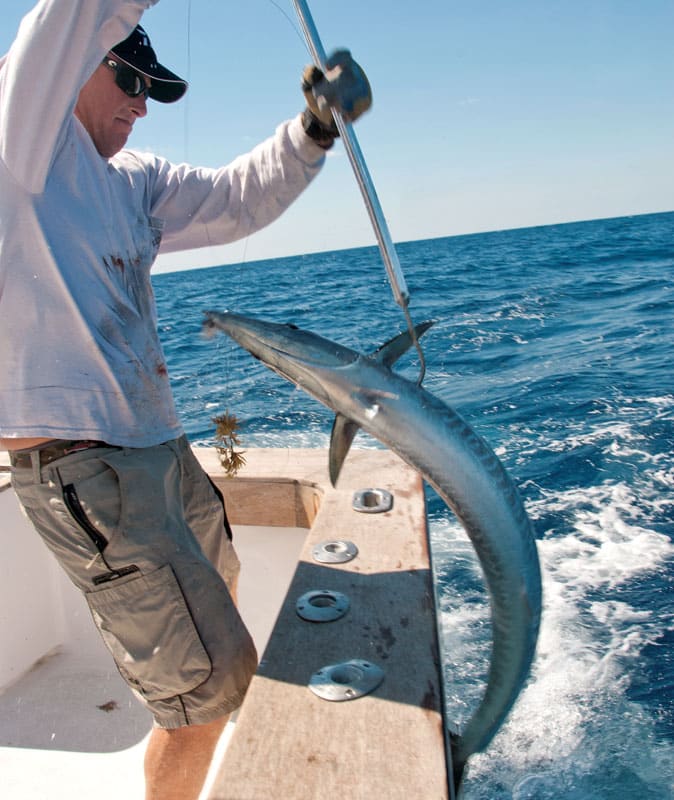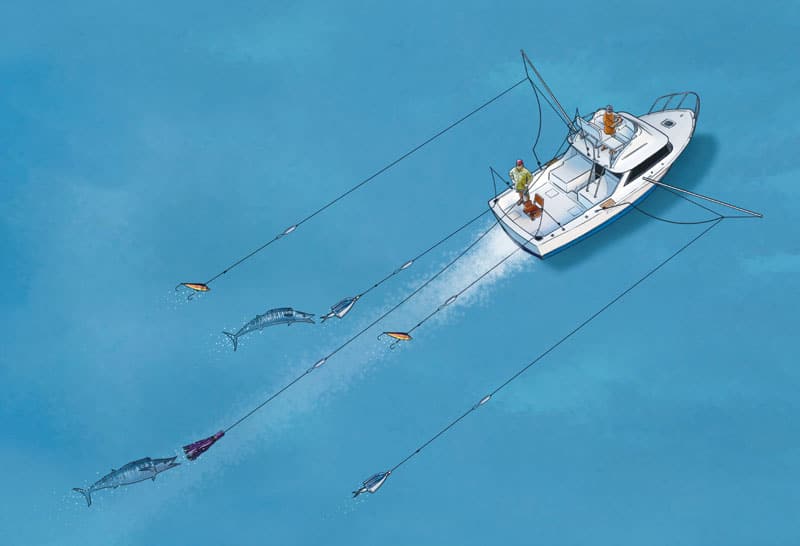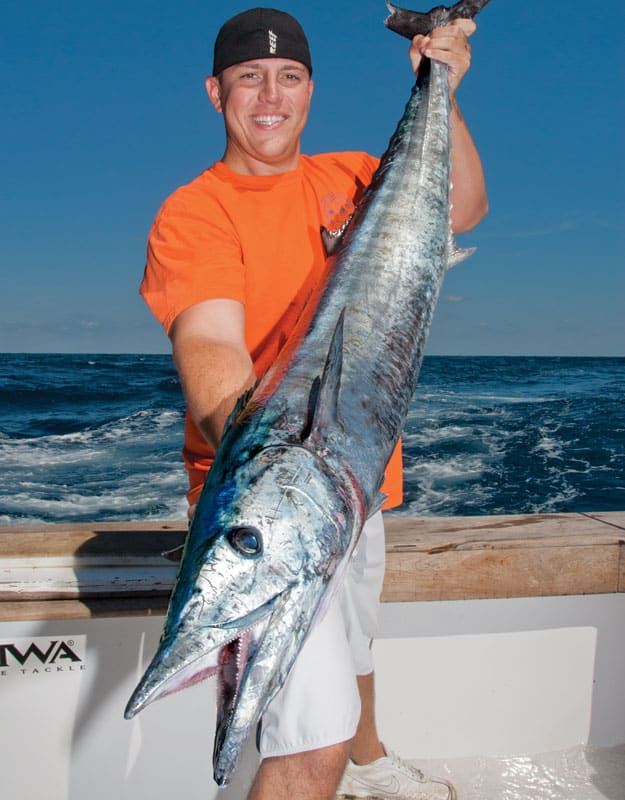Mid-Atlantic Wahoo Fishing
 When searching for tuna, marlin or dolphin, always have your wahoo tackle available too. Wahoo just might be hanging under that floating log or along the edge of the continental shelf.
Ric Burnley
When searching for tuna, marlin or dolphin, always have your wahoo tackle available too. Wahoo just might be hanging under that floating log or along the edge of the continental shelf.
Ric Burnley
The first time I saw a wahoo, we were trolling the edge of the Gulf Stream when a quicksilver missile shot 10 feet out of the water and divebombed the center bait 30 feet behind the boat. “Woohoo!” I shrieked. “No,” the captain laughed, “that’s a wahoo!”
My fascination with these fish has lasted a lifetime. Each spring, as warm waters return to the mid-Atlantic, wahoo show up on the edge of the continental shelf. From the canyons off DelMarVa to the valleys and humps off North Carolina’s Outer Banks, the fish stick around all summer and into the fall.
Where to Catch Wahoo Endgame
Gaff a wahoo with care: They are expert hook throwers with razor-sharp teeth.
Ric Burnley
Endgame
Gaff a wahoo with care: They are expert hook throwers with razor-sharp teeth.
Ric Burnley
Off the Mid-Atlantic coast, wahoo can be caught almost anywhere along the edge of the continental shelf. Capt. Jason Snead, who fishes the Outer Banks, looks for wahoo to arrive in late spring. “We start to see the fish in May,” he says, “when the water temperature hits the middle 70s.”
The fish show up a little later off Virginia Beach, Virginia. Local pro Capt. Pat Foster, known as the Admiral, doesn’t expect wahoo until the end of June. Farther south, Hatteras Inlet, North Carolina, is wahoo world. Capt. Kenny Koci, on the charter boat The Big Tahuna, never stops fishing for wahoo. “We catch them year-round,” he says. “There isn’t a month that hasn’t produced ’hoos.”
All three captains agree that late summer to early fall is the pinnacle of wahoo season. “The warmer the water, the better,” Koci says. “We’ll often find wahoo in water up to 80 degrees.”
The skippers also agree that wahoo can be hard to predict. “You have to wait for the wahoo to find you and then be ready when they show up,” Snead says.
And all three say the best way to find wahoo is to find a wahoo. “Where you catch one fish, you’re bound to catch more,” explains Snead. When he hooks a wahoo, he turns the boat and makes a few more passes through the same water. “Keep making bigger and bigger circles in the same area,” he says. “They don’t usually travel alone.”
It takes a lot of fuel to power wahoo, so these fish seldom wander far away from the kitchen, and they can’t afford to be picky. These fish will eat anything from squid to mackerel, but they really seem to love dolphin. Find a school of bait or a piece of structure that holds dolphin, and you’ll often find wahoo too.
Any drop or rise in the bottom along the edge of the continental shelf will also hold these fish, especially crossroads, where the current intersects structure. Color changes, weed lines and other flotsam are also known ’hoo hide-outs.Foster recalls finding a floating tree one day. “Every pass, we pulled two or three wahoo off of it,” he remembers. “They just kept coming.”
Since Hatteras is within easy reach of the edge of the Gulf Stream, the wahoo scenario there is a little different. While Hatteras ’hoos favor floats and weed lines, Koci also looks for the fish over rock pinnacles from the Rockpile to the 200 Rocks. He most often finds wahoo on the inshore or upcurrent side of structure. Koci says that wahoo offer offshore anglers who are new to the area an easy opportunity for glory. “Just find the break and start trolling,” he says. “You’re bound to run into ’hoos.”
North Carolina Wahoo Rigs Koci runs lures directly off of 50-pound outfits spooled with 200-pound braid. Flat lines pull Marauder plugs 30 yards back. A 400-pound snap swivel on the main line clips to a loop crimped in 20 feet of 200-pound mono ending in a 220-pound Spro wind-on swivel, clipped to a foot of 7-strand cable, snap-swiveled to the lure. Thirty to 40 yards behind the Marauders he runs chrome-headed Ilanders. The main line snaps to a 36-ounce in-line sinker, snapped to 60 feet of 200- pound mono leading to the Ilander. An 80-pound rig with 100-pound mono pulls a Mold Craft Wide Range 100 yards back. Lures carry a 9/0 recurve hook.
Joe Mahler / www.markerjockey.com
Koci runs lures directly off of 50-pound outfits spooled with 200-pound braid. Flat lines pull Marauder plugs 30 yards back. A 400-pound snap swivel on the main line clips to a loop crimped in 20 feet of 200-pound mono ending in a 220-pound Spro wind-on swivel, clipped to a foot of 7-strand cable, snap-swiveled to the lure. Thirty to 40 yards behind the Marauders he runs chrome-headed Ilanders. The main line snaps to a 36-ounce in-line sinker, snapped to 60 feet of 200- pound mono leading to the Ilander. An 80-pound rig with 100-pound mono pulls a Mold Craft Wide Range 100 yards back. Lures carry a 9/0 recurve hook.
Joe Mahler / www.markerjockey.com
Foster and Snead usually encounter wahoo when they are looking for tuna, marlin or dolphin, so they rarely have the security of wire line. For these guys, the go-to bait for wahoo is an Ilander over a large ballyhoo, a No. 4½ Drone spoon dragged 60 feet behind a No. 8 planer, or 36-ounce in-line sinker on a flat line. “Any time there are wahoo around,” Foster says, “I’ll fish a planer rod.” If they encounter big numbers of wahoo, the pros replace both flat lines with planers.
Snead relies on purple, dark red and black skirts on his Ilanders. “There’s something about dark colors,” he says. He likes dark spoons too but says that white and silver can be hot as well. Fishing out of Hatteras, Koci stresses the addition of Mylar and flash to his baits. “Wahoo like the bling-bling,” he explains.
Even with mono line, anglers have a chance at catching toothy wahoo. To keep one from cutting the leader, Snead suggests leaving the boat in gear while fighting the fish. “If you can keep the fish coming in, keep the line tight and keep the boat moving forward, you can keep the wahoo from biting through the leader.”
Wahoo High-Speed TrollingA killer wahoo tactic is high-speed trolling with heavy skirts or big plugs, which replace Ilanders and SeaWitches. “High-speed trolling works best on glass-calm days when the fish are finicky,” Koci says. “When it is choppy, we have better luck trolling traditional Ilanders and SeaWitches.”
Koci also likes to drop vertical jigs to wahoo. “Anytime we encounter a float, we’ll start by dropping a 250-gram jig to prospect for wahoo.” He uses a short piece of seven-strand wire to attach the hook to the jig. “Catching wahoo from a dead boat with relatively light jigging gear is a whole ‘nother world,” he says. The jarring strike, lightning run and tenacious battle prove again and again how this fish got its name. Koci laughs, “It gives new meaning to the name wahoo.”
Mid-Atlantic Wahoo Fishing SpotsWahoo occur east of 20 fathoms from New Jersey to North Carolina. Look for them along the edge of the continental shelf and in Wilmington Canyon, Baltimore Canyon or any of the offshore humps and hills. Out of Virginia Beach, the Fingers, Norfolk Canyon and the east side of the Cigar Seamount can be hot spots. From Oregon Inlet, North Carolina, target wahoo on valleys and plateaus including the Point, Tuna Hole and Whale Hole. Hatteras offers the most wahoo options, with fish hanging on the Beach, Rockpile, Big Rock, 200 Rocks and any of the deep wrecks.
Wahoo Fishing Tackle Wahoo Grin
Some consider catching wahoo a chance occurrence, but savvy captains know how to target them reliably.
Ric Burnley
Wahoo Grin
Some consider catching wahoo a chance occurrence, but savvy captains know how to target them reliably.
Ric Burnley
While anglers never know when or where they’ll encounter wahoo, they had better be ready for the fish. These high-speed killers will eagerly jump on baits intended for tuna, dolphin or marlin, but targeting wahoo takes planers, vertical jigs and high-speed plugs. While wire leader may seem like the answer to wahoo’s slicing teeth, these wary fish often spot that trick. All three captains prefer to take their chances with fluoro leader over spooking fish with wire line.
- When: May to November, peaking September to October
- Rods: Stout trolling rod for planers and a medium-heavy stand-up rod for trolling; heavy-action 5 1⁄2-foot, 30-pound stand-up rod for jigging
- Reels: Heavy-duty 50s spooled with 100-pound braid for trolling
- Lures: SeaWitches and Ilanders in purple, red or black for trolling; Braid Marauder, Halco Max, Yo-Zuri Bonita, Nomad MadMac, or heavyweight Ilander or Mold Craft Wide Range for high-speed trolling
- Jigs: Williamson 250-gram speed jig, Shimano Ocea Stinger Butterfly or similar vertical jig
The post Mid-Atlantic Wahoo Fishing appeared first on Salt Water Sportsman.
- Home
- About Us
- Write For Us / Submit Content
- Advertising And Affiliates
- Feeds And Syndication
- Contact Us
- Login
- Privacy
All Rights Reserved. Copyright , Central Coast Communications, Inc.